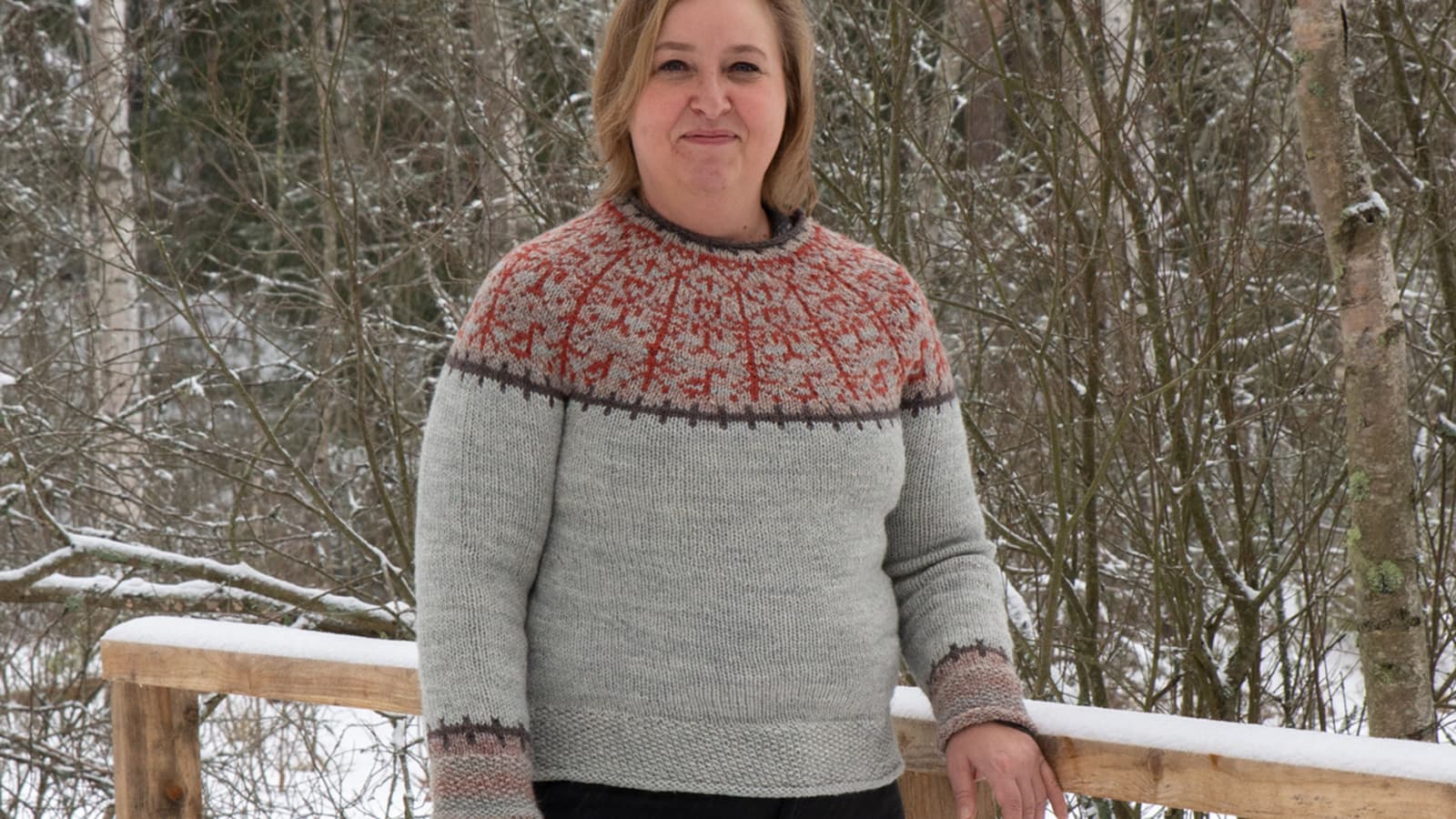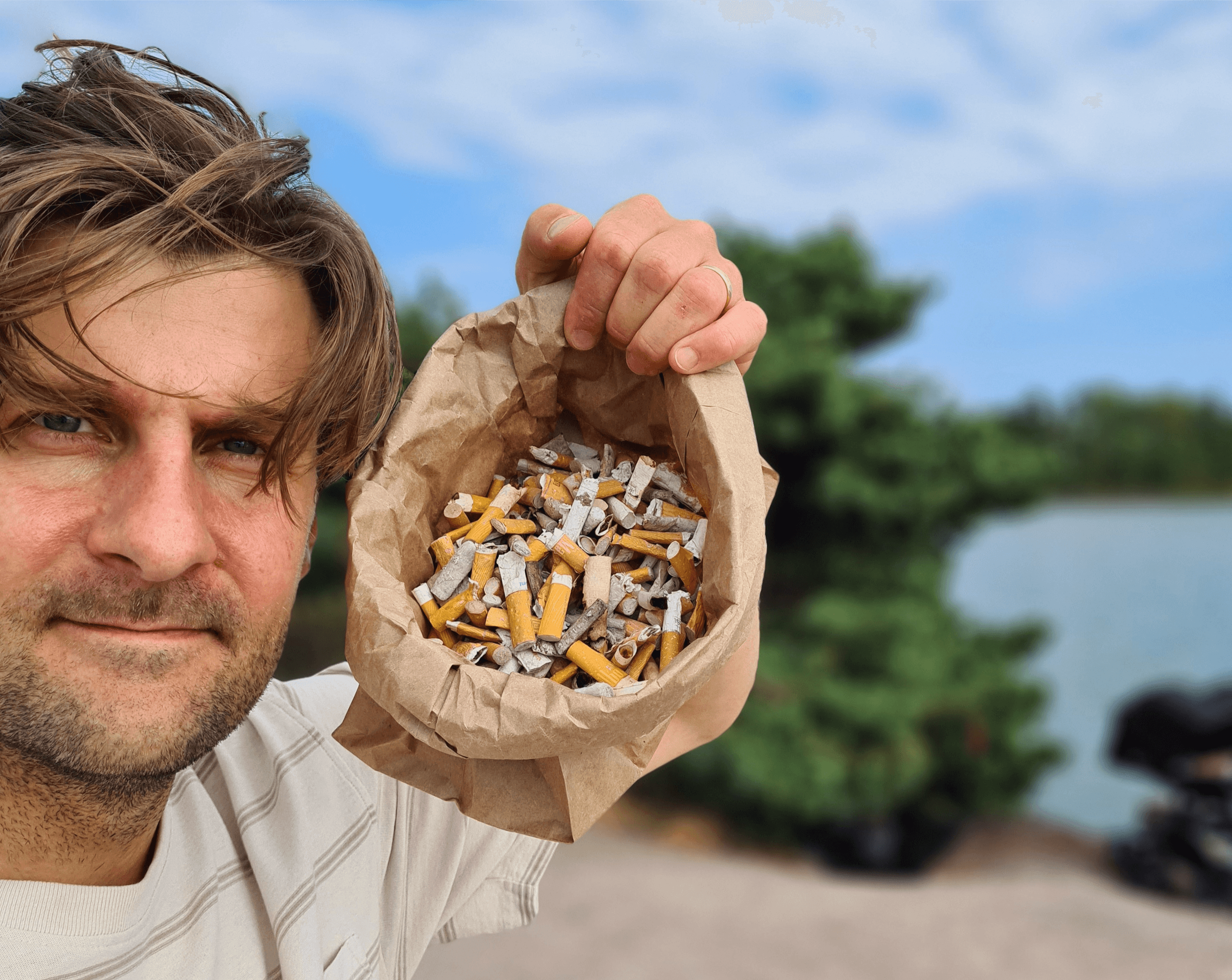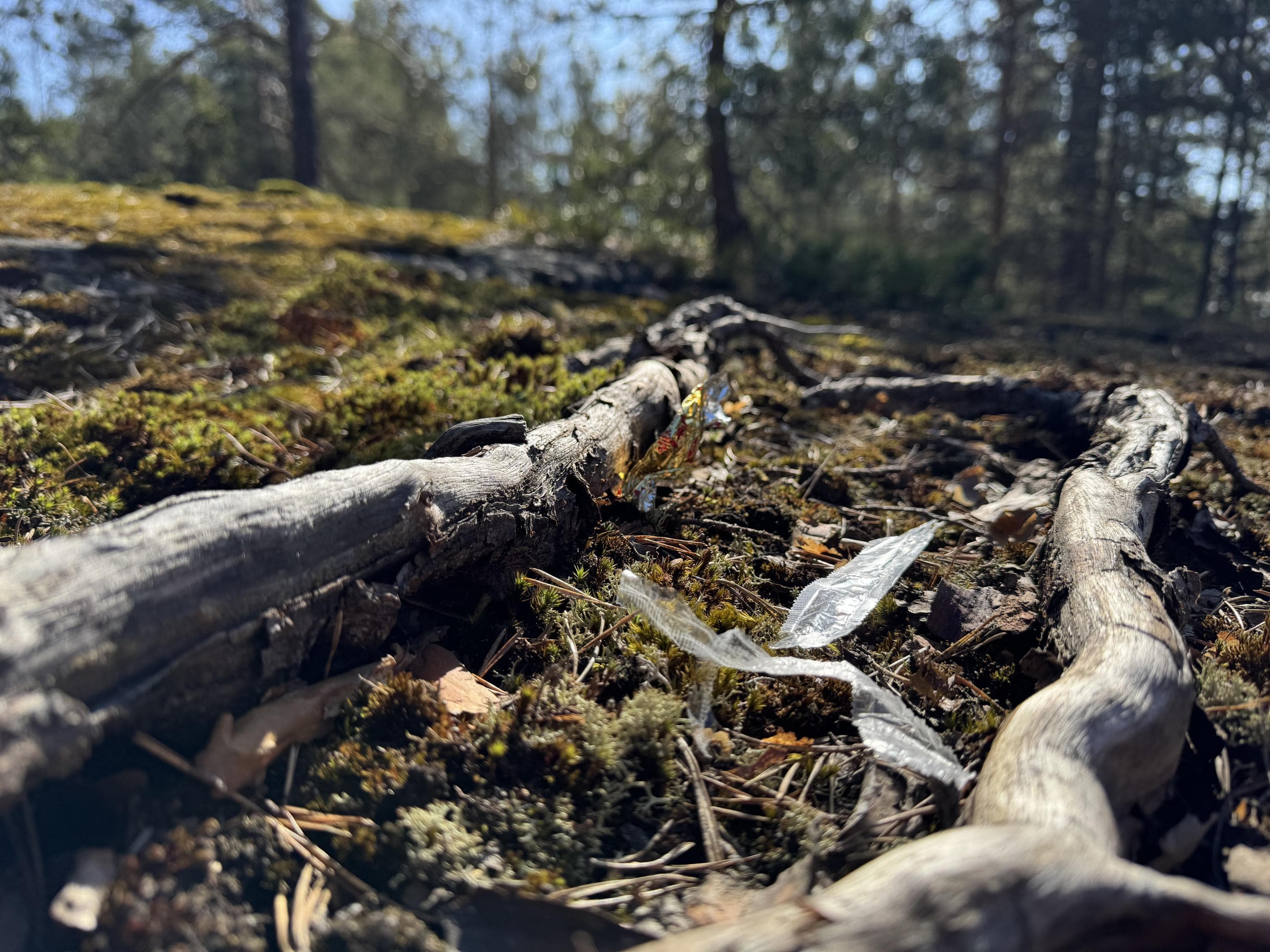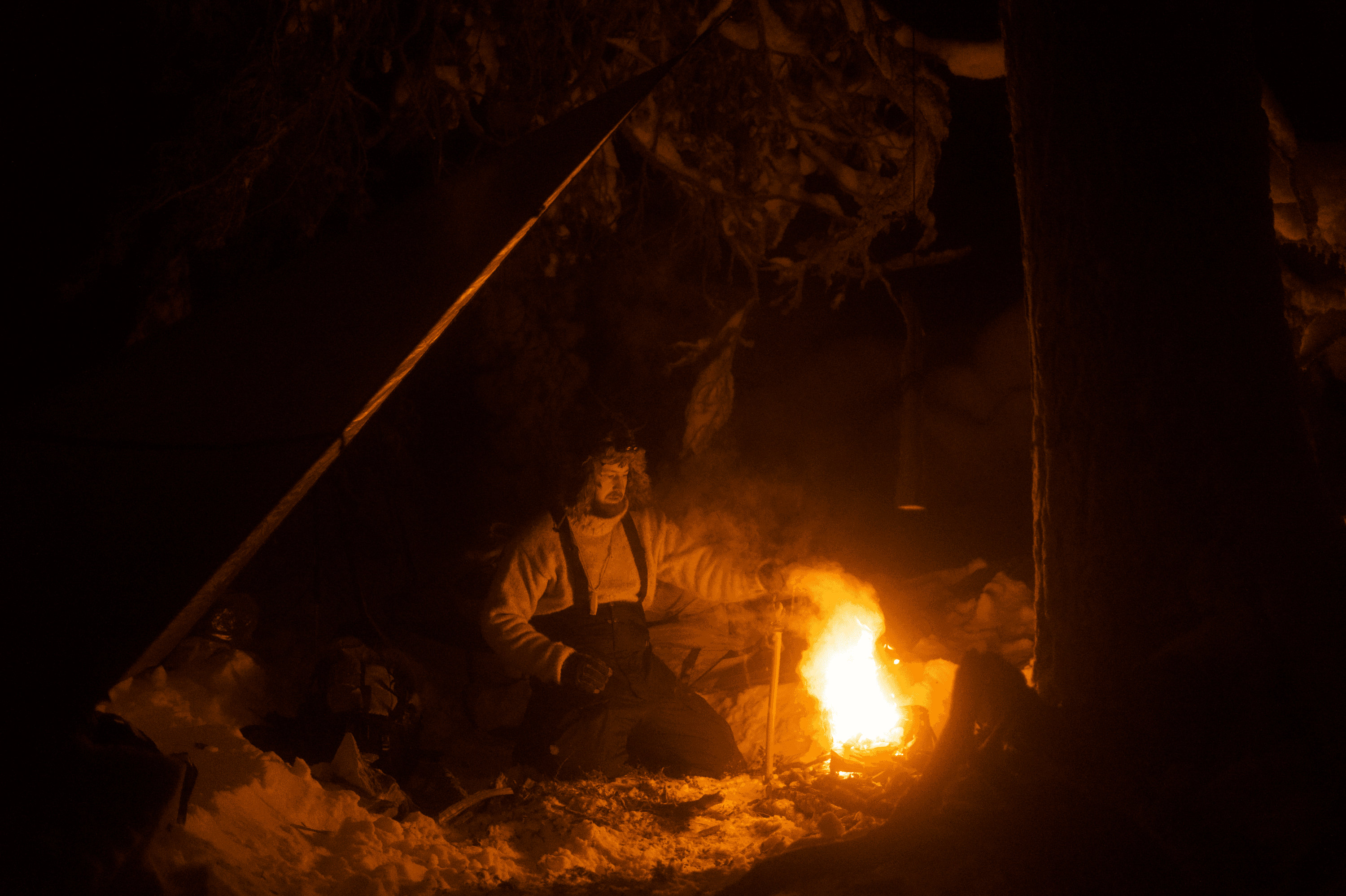A Personal Path to Nature: Wool Sweaters, Trash Bags, and Survival Skills
They share love for nature and a desire to do things their own way—and the ability to inspire others. Riina Meriläinen knits national parks into wool sweaters, Teemu “Eino” Oinio has made litter picking a lifestyle, and Sakari “Sakke” Raappana practices survival skills without macho bravado.
Sweaters from the trails – National Parks transformed into knits
Riina Meriläinen’s first hiking experience was about four years ago on the Karhunkierros Trail. That trip sparked her passion for hiking and launched a major knitting project.
“When we were planning the next trip to Hossa, I saw rock paintings in a book that stuck in my mind. I thought it would be cool to make a sweater inspired by them and wear it to Hossa.”
That’s how it all started. Now Riina has visited all of Finland’s national parks and designed and knitted a unique sweater for nearly each one, capturing the spirit of the park or the trip.
“In some parks, we’ve hiked for miles with backpacks; in others, we just had snacks and laughed around a campfire.” Although she’s covered the parks quickly, she’s in no rush to finish the knitting project—what matters most is the joy of creating.
“A couple of sweaters have been redone, and a few are being unraveled because I wasn’t happy with them. So a few are still missing. They’ll be finished when the right idea comes and I’m happy with the result. The sweaters need to be good, but they’re made with a good vibe!”
Riina describes knitting as a relaxing state that balances her work life. “When I pull out my knitting, my brain goes into relaxation mode,” she says.

Sweaters tell stories
Each sweater Riina designs is a story, memory, or feeling woven into stitches and patterns.
Many of her designs are inspired by small but meaningful moments in nature. The Repovesi sweater features three foxes—a nod to a trip with three women. The Karhunkierros sweater includes a suspension bridge, a memorable moment balancing with a heavy backpack. The Torronsuo sweater is made from leftover yarns and features layers of the bog, butterflies, and dragonflies she saw on a hot summer day.
The Petkeljärvi sweater was inspired by trail markers in shades of pink. “The yarn is called ‘wind’—it was a very windy day when we were there. I tried to capture the texture of Karelian pine bark.”
The Helvetinjärvi sweater reflects the knitter’s own “hell”: separate pieces, a skewed pattern, and synthetic yarn. The Lemmenjoki gold panner sweater includes sluices, shovels, and even gold thread. It’s especially meaningful to Riina because Lemmenjoki was the last of the 41 national parks she visited—wearing the sweater, of course.
Before this project, Riina hadn’t written knitting patterns, but she taught herself so others could knit the national park sweaters too. Now about twenty patterns are available for sale, with more on the way. “The best thing is if someone else finds joy in my sweaters—or if I ever see someone wearing one I designed out in the wild!”

Nature Walk? – Take a Trash Bag Too
“I now have a trash radar on all the time, whether I want it or not. I’ve found money, phones, and credit cards in nature,” says Teemu “Eino” Oinio, who has spent years picking up litter in his surroundings and inspiring others to do the same.
Seven years ago, his dog Sulo kept taking him out for walks. On those walks, Eino began to notice what many others overlooked: trash scattered throughout Helsinki’s Central Park. Plastic bags, cans, papers, forgotten items. Not a massive landfill, but a jarring mess everywhere.
Something had to be done. From one social media post marveling at the trash, Roskapäivä (“Trash Day”) was born. It started as a social media account documenting litter and is now Eino’s part-time job, including school visits and leading trash walks. Schools, families, daycare centers, and even companies have joined in to organize their own Trash Days.
What drives Eino most is the desire to get others excited about a litter-free world. “One person sets an example, ten follow. And each of them inspires more—that’s how a chain reaction starts.”
Roskapäivä isn’t just a campaign or a single day a year—it’s a way of life and a way of seeing the world. Eino, the “terrain cleaner,” says that once you start noticing trash, you can’t unsee it. He often carries a bag—just in case.
“I pick up trash because I can, because it feels good. If environmental issues are overwhelming, the best remedy is to do something concrete.”

The power of example
Picking up trash doesn’t require special skills, and kids are especially easy to get excited about “trash hunting.”
“This is such a low-barrier activity—it couldn’t be easier. No special gear or even time is needed—just take a bag when you go out.”
According to Eino, the key to inspiring others is to make trash picking easy, interesting, and fun. “Guilt-tripping doesn’t help; being relaxed, setting an example, and using humor work better.”
In his social media videos, Eino showcases tools and gives tips for collecting. Sometimes he highlights unusual finds. “It’s amazing what you can find—once I found a sausage package from 1982!”
The same tricks work during school visits: humor and the “gross-out” factor. “Students remember the decades-old bus tickets and full dog poop bags best.”

Survival isn’t just extremes – Drawing from wilderness tradition
When people think of survival skills, they might imagine military special forces or extreme reality TV. For Sakari “Sakke” Raappana, survival skills aren’t about preparing for the end of the world, but about managing in nature with limited gear for a certain time.
“I’m allergic to macho wilderness talk. For me, survivalism is about drawing from Finnish wilderness traditions and having the mental confidence that I’ll be okay.”
Sakke’s survival trips range from short experiments to longer hikes where he tests skills and endurance one aspect at a time. For example, he spends nights in the forest without a sleeping bag or tent, using only a tarp and a fire, or does a week-long hike without food. These are ways to test himself—not because he has to, but to know he could if needed.
He shares his experiences but also mistakes on social media —so others can learn.
“I think everyone should know at least the basics—how to make a fire, find shelter, and prioritize needs,” he says. These skills can be crucial if a hike unexpectedly turns into a survival situation.

Responsibly and with respect for nature
Sakke recommends starting by spending time in nature and observing it. According to him, national parks and nature reserves are great places to start practicing survival skills, as they better reflect the environment our ancestors once roamed than commercial forests.
“During a day hike, you can practice navigating by natural signs or do mental exercises about potential emergency shelters, firewood, or just get mentally closer to the environment our ancestors lived in, dependent on nature.”
However, not all survival skills can be practiced anywhere. “Nature reserves and national parks have their own rules—you can’t just make open fires or build shelters however you want.” That’s why he uses parks mainly for movement, navigation practice, and light gear training.
He does more demanding exercises in wilderness areas or on private land with permission, where there’s more freedom to experiment with things like fire-making.
“No matter the place, survival training is always done responsibly and with respect for nature.”

